|
 Dwight Peck's personal website Dwight Peck's personal website
Corsica in the Off Season, 2007
Corsica, the grudgingly-French
island off the coast of Italy. We're catching the off-season rates,
late November and early December 2007.
You may not find this terribly rewarding
unless you're included here, so this is a good time for casual and
random browsers to turn back before they get too caught up in the
sweep and majesty of the proceedings and can't let go.
Hike to Punta Mortella

Another coastal walk -- Kristin is Kangooing
us up from Bastia over the Col de Teghime at the base of the Cap
Corse, down past the town called Patrimonio, to St-Florent, still
another lovely little yachting port. We're here to walk along
part of the coast of the Désert des Agriates -- once the
breadbasket of the Genoese, but since then monocultured into a
"Désert". (Think the US midwest after Archer
Daniels.)

St-Florent, the chief town of the Golfe de St-Florent.
We'll be walking out on the far side of the bay there, 30 November
2007.

Downtown St-Florent in the off-season. Bilingual
road signs are so cool, they have such a kind of insistent dignity
about them. Even when they say virtually the same thing.

The Genovese citadel at St-Florent

St-Florent its ownself

The view from the St-Florent citadel northwards
along the west coast of the Cap Corse.
Probably a hundred stories out there, most of them still untold.

And the view from St-Florent back over the
pass we've just traversed, Bastia on the far side of it, and
Kangoo dreading the return in the dark.

And once again the citadel. Unimpressive, locked
up tight, even the toilets are locked up. Okay, forget it, we
don't need you! There will be other toilets.

We've successfully cajoled and prodded Old
Kangoo out this far, a rutty old dirt road to the Anse de Fornali,
a little cove and residence of some no-doubt-deservedly well-to-do
individuals with their own boats and a faux-castle homestead on
the right side of it. We're going left.

A look back at St-Florent over on the far side
of the Golfe de St-Florent, and now we're on our march.

And after a certain space of plodding along,
telling scabrous Cheney jokes, our destination comes into view,
the Punta Mortella (tiny white things in the distance).

Weird Poseidon Grass all over the place. And
Kristin.

A Wetland of Purely Local
Importance.
Actually, there are two Wetlands of International Importance on
Corsica, the Etang de Biguglia (1991)
near Bastia and the Mares
temporaires de Tre Padule de Suartone, designated by
France for protection under the Ramsar Convention just earlier
this year <[i.e., in 2007. And three more since then (2012).]

Punta Mortella, and more Poseidon, or Neptune,
Grass all over the shop floor.

LOTS of Poseidon Grass (Posidonia oceanica).
How about this?: "120 million years ago P. oceanica covered the coastal plains of an ocean that straddled the equator.
Drifting over millennia with the tectonic plates, today P.
oceanica occurs only in the Med and around the southern coasts
of Australia" (source).
"Over centuries the rhizomes form mats
which rise up into reefs that help to trap sediment and mediate
the motion of waves, thus clarifying the water and protecting
beaches from erosion. Dead leaves are shed in the autumn and can
be seen washed up on beaches", and
here they are!

Neptune Grass banks that have been here so
long that they've been eroded by the waves. They look like crap
but they're a protected species (in Catalunya), and aside from
dissuading sunbathers they have significant human uses: "Dried
P. oceanica leaves were traditionally used to stuff mattresses
and pillows (apparently deterring bed bugs), to feed cattle, to
provide packing material, and even to thatch roofs. Once viewed
as beach litter, the importance of this biodegradable material
in the ecosystem is now being recognised and several local authorities
along the Spanish coasts hold annual information drives about
preserving this seagrass and to explain their new policy of leaving
areas of beach in their natural state."

Kristin sprints along the coastal path

We're approaching the River Santu, where it effluesces
into the sea

One of the few times when I can envy people who
wear "hiking sandals"
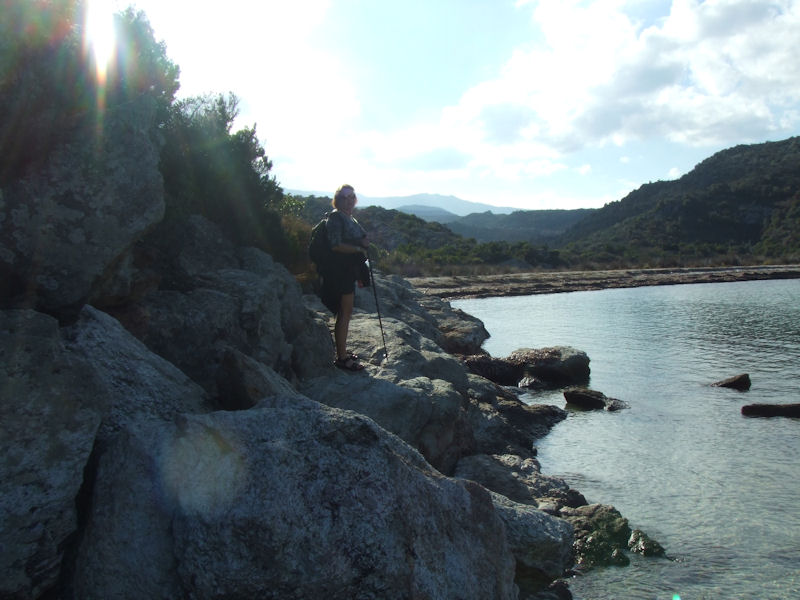
So, a certain smugness amongst the hiking sandelers.

Preparing to cross the River
Santu. Another time when hiking sandals are probably a
plus.
In re: the tracks on the sand: we were met by a little crowd of
"mountain bikers" lugging their bikes along the trail,
but apparently here they were able to mount up and pedal furiously
for a few moments.
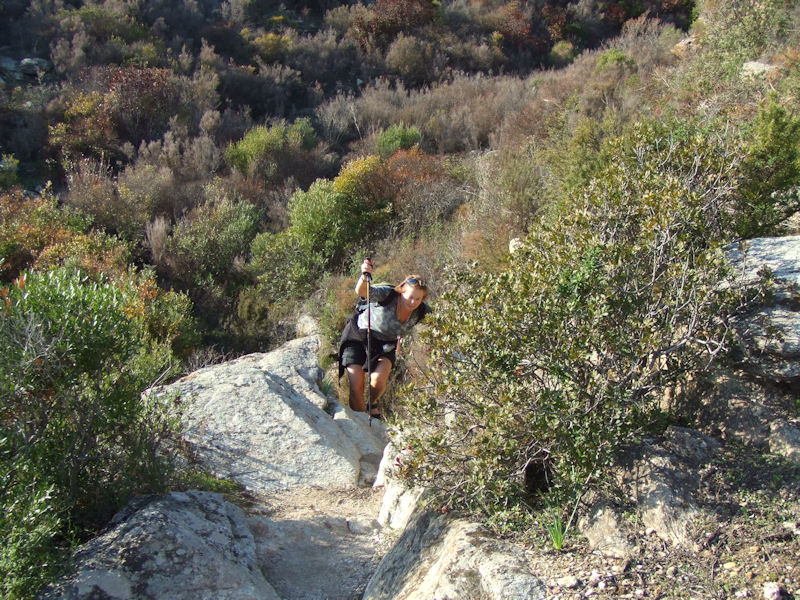
Another time when I'd prefer my normal walking
boots.

The tower of Mortella in the offing

All right, get ready for this. A significant
stream of Global Military History began
right here. This is the Tower of Mortella,
got that?

That Old Wreck, the tower on the Point of Mortella,
one of many built all round Corsica by the Genovese (as we've
seen) to warn of the onset of North Africans, was assaulted on
7 February 1794 by two British warships and was then captured
by land forces under Sir John Moore "after two days of heavy
fighting". (Did anyone know why?)

The point is that the two warships cannonaded
the son of a bitch endlessly, with no effect, and the Big Cheese
at that time, presumably His Admiral Nelsonship, was so impressed
that he decided to replicate this design all over the Empire,
i.e., at that time, all over the world.
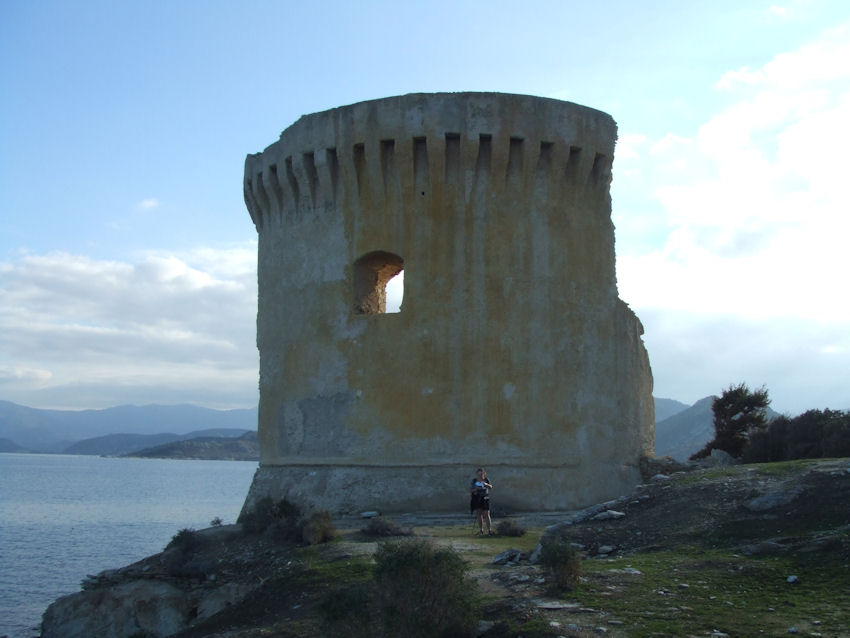
A genius in military architecture, but weak
in spelling, he turned Mortella into "Martello",
and Martello towers from the 19th century are now, basically,
everywhere. I've had my photograph taken proudly, with a good
friend at the time, at one of the two Martello Towers on the Plains
of Abraham in Québec City, and eleven of the original sixteen
Martello towers built in Canada are still standing.

But, if you want to see a Martello Tower, especially
one that's in better shape than this original,
you can go to Australia, Barbuda, Bermuda, elsewhere in Canada,
all over Ireland, Jamaica, Mauritius, Sierra Leone, South Africa,
Sri Lanka, and even the USA. The basic idea was, it seems, Superthick
Walls, one officer and 25 men in the garrison, and a single
360° heavy artillery gun on top of it, and a stairway up the
outside that was removable if necessary. In Corsica, the torregiani manned the thing and lit fires to warn everybody when things got
rough.
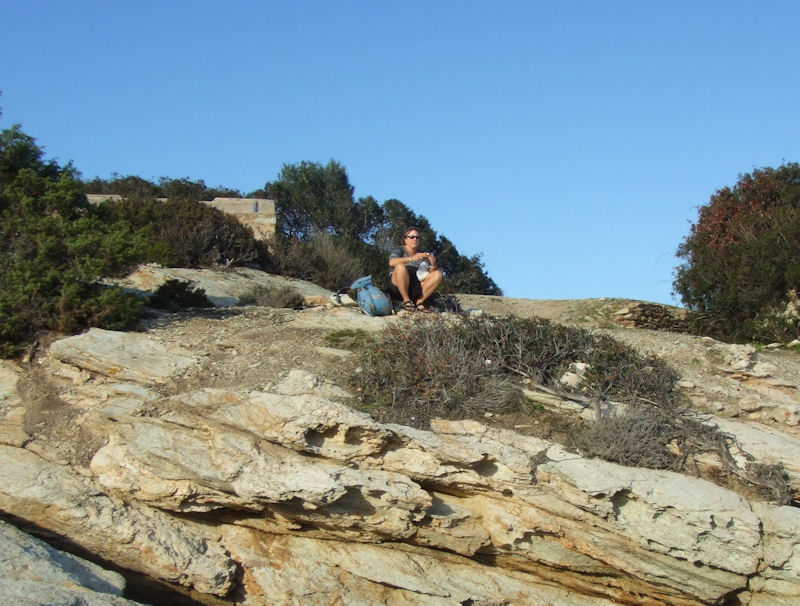
Kristin, thinking about Martello Towers and smoked
Corsican saucisses and the return walk.
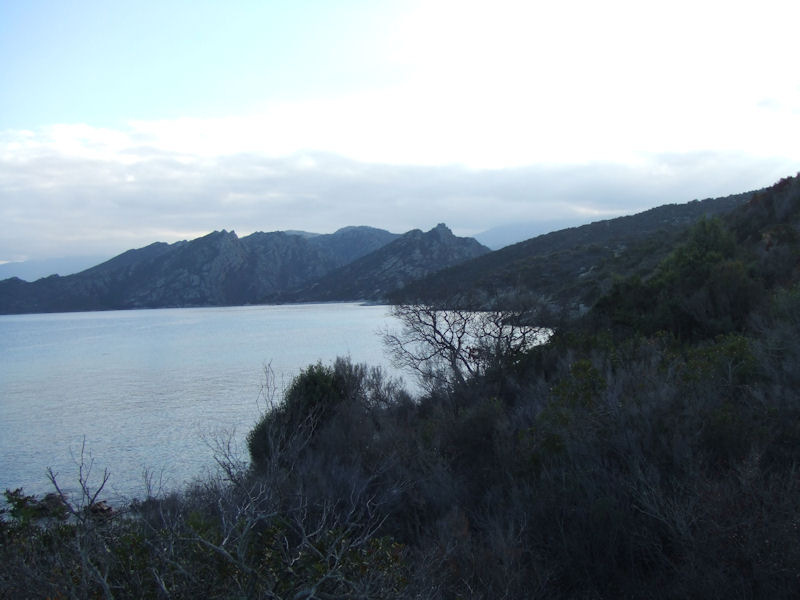
All that said, it's time to start back again,
as the day begins to darken somewhat.

And a last look at the grand-daddy of all the
world's Martello Towers.

Base map: http://z.about.com/d/goeurope/1/0/g/Y/corsica-transportation.gif
        

 Feedback and suggestions are welcome if positive, resented if negative,
Feedback and suggestions are welcome if positive, resented if negative,  .
All rights reserved, all wrongs avenged. Posted 25 December 2007, revised 15 June 2012. .
All rights reserved, all wrongs avenged. Posted 25 December 2007, revised 15 June 2012.
|
 Dwight Peck's personal website
Dwight Peck's personal website












































